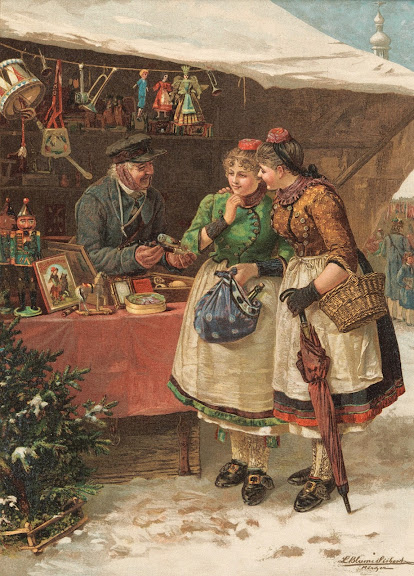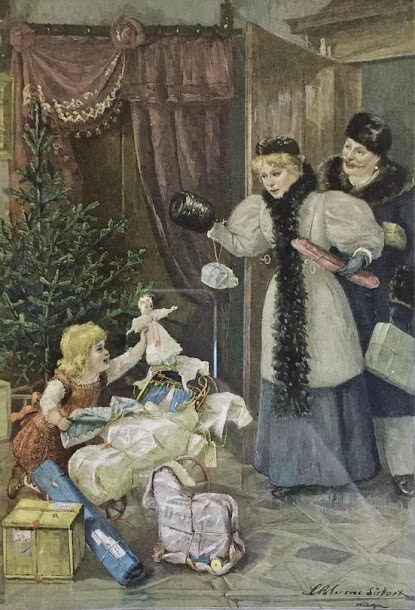That's how we all do feel Christmas today, but Christmas, as we know it, started to be celebrated in the early Victorian Age, thanks to Queen Victoria and Prince Consort Albert (Click on
Queen Victoria and the first Christmas Tree if you want to read this post of
~ My Little Old World
~).
In the pre-revolutionary era, people living in the original 13 colonies fiercely disagreed about how to celebrate Christmas and even whether to celebrate it or not.
Yes, English settlers who reached the New World brought with them the Christmas debate. As the XVIth century drew to a close, a group of Protestant reformers, known as the Puritans, sought to purify the Church of England and separate it from the Roman Catholic traditions which they considered excessive. This included Christmas, which had roots in the pagan Roman winter festival of Saturnalia, as well as the Norse holiday of Yule. At the time, Christmas celebrations in England lasted almost two weeks, from the day of the birth of Jesus Christ, December 25, to the Twelfth Day, January 6, and consisted of lively festivities that included feasting, gambling, drinking and masquerade dances.
Pilgrims from New England preserving Christmas Day celebrations
For those who reached Virginia in 1607, Christmas remained an important holiday. While celebrations may have been limited given the harsh realities of life in the struggling new settlement of Jamestown, everyone continued to view Christmas as a sacred holiday and a day of rest. In the 1620s and 1630s, Christmas was established as a landmark in the Virginia colony's legislative calendar, according to Jamestown settlement historian Nancy Egloff. The laws written on the books in 1631, for example, established that churches had to be built, in the areas where they were needed, before the recurrence of the "feast of the nativity of our Christ the Saviour".
In contrast, the Pilgrims who reached Plymouth belonged to a group of Puritans known as the Separatists. They regarded their first Christmas in the New World as just another working day, so Governor William Bradford noted in his journal that the colonists began building the colony's first house on December 25, 1620.
The following year, when a group of newly arrived expats refused to work on Christmas Day, Bradford let them off the hook until they were 'better informed'. But he clarified the situation after finding them playing while everyone else worked.
"If they have preserved its [Christmas] celebration as a matter of piety, let them stay at home," wrote Bradford. "But there shouldn't be any games or revelry in the streets."
Ultimately, Puritans in the Massachusetts Colony made Christmas celebrations illegal.
The bitter differences between Puritans and Anglicans would lead the population to the first English Civil War (1642-46), after which the Puritans came to power and banned the celebration of Christmas, Easter and various saints' days. In their strict view of the Bible, only the Sabbath was sacred. Christmas, with its pagan roots, was particularly unacceptable.
A Puritan rebuking children for picking holly during the holiday season
Getty Images
The Massachusetts Bay Colony, founded in 1630 by a group of English Puritan refugees, followed this suit. Under a law passed in 1659, "anyone found to observe such a day as Christmas or the like, by refraining from work or attending banquets or celebrating in any other way would be punished with a fine of five shillings".
In 1681, after the English Civil Wars ended and the monarchy was restored, Massachusetts bowed to mounting pressure and repealed some of its more restrictive laws, including a ban on celebrating Christmas. However, Puritan opposition to Christmas remained strong throughout the colonial period: Most businesses often stayed open on December 25, and Massachusetts did not officially recognize the holiday until the mid-19th century.
Despite Puritan efforts, many settlers in New England celebrated Christmas by importing English customs such as drinking, feasting, mumming, and wassailing, all activities allowed to adults. Mumming, or "masking," involved people dressing up in costumes and going from house to house putting on performances to beg for some change or a bowl of hot soup. Wassailers also went between houses, drinking and singing as they passed bowls filled with spiced beer or mulled wine.
In the central and southern colonies, where there was greater religious diversity, Anglicans, Roman Catholics, Lutherans, Moravians and other groups introduced their own Christmas traditions, both religious and secular, to the New World. Far from still being a childhood-focused holiday, the Christmas season was filled with adult activities such as parties, hunts, dances and, of course, church services. People decorated homes and churches with evergreen plants such as holly, ivy, mountain laurel, and mistletoe.
The Holly Cart by George Goodwin Kilburne (1839-1924)
Yuletide by George Goodwin Kilburne (1839-1924)
In addition to mumming and wassailing, revelers in southern colonies like Virginia enjoyed themselves sing English folksongs such as 'The First Noel', 'God Rest You Merry Gentlemen' and 'The Holly and the Ivy'.
Although Christmas had become a relatively traditional celebration by the mid-XVIIIth century, it was not yet officially recognized as a holiday by the time of the Revolutionary War, so much so that in 1789 Congress went so far as to hold its first session on Christmas Day. It would take nearly a century for Congress to declare Christmas a national holiday, which it finally did in 1870. By then, traditions such as the Christmas tree, Santa Claus, and gift-giving had made their way into American conventions, helping to transform December 25 into the family day that we all love and know.
E' così che tutti noi avvertiamo il Natale, ma questo giorno di festa, come lo conosciamo oggi, iniziò ad essere festeggiato agli albori dell'epoca vittoriana, grazie alla regina Vittoria ed al principe consorte Alberto (Clicca su La regina Vittoria ed il primo albero di Natale se vuoi leggere questo post di ~ My Little Old World~). Nell'era pre-rivoluzionaria, le persone che vivevano nelle 13 colonie originarie erano in feroce disaccordo su come celebrare il Natale e persino se celebrarlo oppure no.
Ebbene sì, i coloni inglesi che raggiunsero il Nuovo Mondo recarono con loro il dibattito circa il Natale. Con la fine del XVI secolo, un gruppo di riformatori protestanti, noti come puritani, cercò di purificare la Chiesa d'Inghilterra e di separarla dalle tradizioni cattoliche romane che consideravano eccessive.
Ciò includeva il Natale, che aveva radici nella festa invernale pagana romana dei Saturnali, così come nella festa norrena dello Yule. A quel tempo, le celebrazioni del Natale in Inghilterra duravano quasi due settimane, dal giorno della nascita di Gesù Cristo, il 25 dicembre, al Dodicesimo Giorno, il 6 gennaio, e consistevano in vivaci festeggiamenti che includevano banchetti, giochi d'azzardo, bevute e balli in maschera.
IMMAGINE 2 - Pellegrini del New England che conservano le tradizioni natalizie
Per coloro che raggiunsero la Virginia nel 1607 il Natale rimase una festa importante. Sebbene le celebrazioni possano essere state limitate, data la dura realtà della vita contro cui si trovarono a scontrarsi nel nuovo insediamento di Jamestown, tutti hanno continuato a considerare il Natale come una festività sacra e un giorno di riposo. Negli anni '20 e '30 del 1600, il Natale fu stabilito come punto di riferimento nel calendario legislativo della colonia della Virginia, secondo Nancy Egloff, storica dell’insediamento di Jamestown. Le leggi scritte sui libri nel 1631, ad esempio, stabilivano che le chiese dovevano essere costruite, nelle aree in cui erano necessarie, prima della ricorrenza della "festa della natività del nostro Cristo Salvatore".
Al contrario, i pellegrini giunti a Plymouth appartenevano ad un gruppo di puritani noti come Separatisti. Considerarono il loro primo Natale nel Nuovo Mondo solo come un altro giorno lavorativo, tanto che il governatore William Bradford annotò nel suo diario che i coloni iniziarono a costruire la prima casa della colonia proprio il 25 dicembre 1620.
L'anno seguente, quando un gruppo di nuovi emigrati appena arrivati si rifiutò di lavorare il giorno di Natale, Bradford li lasciò fuori dai guai fino a quando non furono "meglio informati". Ma chiarì chiarito la situazione dopo averli trovati a giocare mentre tutti gli altri lavoravano.
"Se ne hanno preservato la celebrazione [Natale] per una questione di devozione, lasciate che se ne stiano a casa", scrisse Bradford. "Ma non dovrebbero esserci giochi o baldoria per le strade."
In definitiva, nella colonia del Massachusetts i puritani resero le celebrazioni natalizie illegali. Le aspre differenze tra puritani e anglicani avrebbero condotto la popolazione alla prima guerra civile inglese (1642-46), dopo la quale i puritani salirono al potere e vietarono la celebrazione del Natale, della Pasqua e dei vari giorni dei santi. Nella loro rigorosa visione della Bibbia, solo il Sabbath era sacro. Il Natale, con le sue radici pagane, era particolarmente inaccettabile.
IMMAGINE 3 - Un puritano che rimprovera dei bambini che stanno raccogliendo dell'agrifoglio durante la stagione natalizia
Getty Images
La colonia della baia del Massachusetts, fondata nel 1630 da un gruppo di profughi puritani inglesi seguì questo esempio. Secondo una legge approvata nel 1659, "chiunque fosse stato trovato ad osservare un giorno come il Natale o simili, astenendosi dal lavoro o partecipando a banchetti o festeggiando in qualsiasi altro modo sarebbe stato punito con una multa di cinque scellini."
Nel 1681, dopo la fine delle guerre civili inglesi e la restaurazione della monarchia, il Massachusetts cedette alle crescenti pressioni e abrogò alcune delle sue leggi più restrittive, incluso il divieto di celebrare il Natale. Tuttavia, l'opposizione puritana al Natale rimase forte per tutto il periodo coloniale: la maggior parte delle attività commerciali rimase spesso aperta il 25 dicembre e il Massachusetts non riconobbe ufficialmente la festività fino alla metà del XIX secolo.
Nonostante gli sforzi puritani, molti coloni nel New England celebrarono il Natale, importando usanze inglesi come bere, banchettare, fare il mumming ed il wassailing, tutte attività concesse agli adulti. Il mumming, o "mascheramento", coinvolgeva persone che si vestivano in costume e, andando di casa in casa, mettevano in scena spettacoli per elemosinare qualche spicciolo o un piatto di zuppa calda. Anche i wassailer viaggiavano tra le case, bevendo e cantando mentre si passavano ciotole piene di birra speziata o vin brulè.
Nelle colonie centrali e meridionali, dove c'era una maggiore diversità religiosa, anglicani, cattolici romani, luterani, moravi e altri gruppi introdussero le proprie tradizioni natalizie, sia religiose che secolari, nel Nuovo Mondo. Lontano dall'essere ancora una festività incentrata sull’infanzia, il periodo natalizio era ricco di attività per adulti come feste, cacce, balli e, naturalmente, funzioni religiose. Le persone decoravano case e chiese con piante sempreverdi come agrifoglio, edera, alloro di montagna e vischio.
IMMAGINE 4 - The Holly Cart di George Goodwin Kilburne (1839-1924)
IMMAGINE 5 - Yuletide di George Goodwin Kilburne (1839-1924)
Oltre al mumming e al wassailing, i festaioli delle colonie meridionali, come la Virginia si divertivano a cantare i canti popolari inglesi come "The First Noel", "God Rest You Merry Gentlemen" e "The Holly and the Ivy".
Sebbene il Natale fosse diventato una celebrazione relativamente tradizionale verso la metà del XVIII secolo, non era ancora ufficialmente riconosciuto come festa al tempo della guerra rivoluzionaria, tanto che nel 1789 il Congresso arrivò al punto da tenere la sua prima sessione il giorno di Natale. Ci sarebbe voluto quasi un secolo perché il Congresso giungesse a dichiarare il Natale una festa nazionale, cosa che finalmente accadde nel 1870. A quel tempo, tradizioni come l'albero di Natale, Babbo Natale e lo scambio di regali si erano fatte strada nelle convenzioni americane, contribuendo a trasformare il 25 dicembre nella festa della famiglia che tutti amiamo e conosciamo.
,1886.jpg)



_Bitte!%20Bitte!_My%20Little%20Old%20World.jpg)



_My%20Little%20Old%20World_jpg.jpg)
_Nr49_Ein%20Hertzensgeschenk_%20My%20Little%20Old%20World.jpg)



_My%20Little%20Old%20World.png)
.jpg)
_My%20Little%20Old%20World.png)




.jpg)






.png)
.png)





